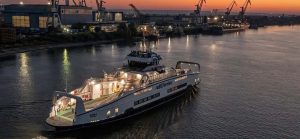
Island 6 departing Romania bound for BC earlier this year
BRITISH COLUMBIA – BC Ferries released its second quarter results for the three and six months ended September 30, 2021.
Vehicle traffic returned to the ferry system in record numbers this summer with pent up demand from the domestic market for seasonal holidays and recreational travel once Provincial Health Officer COVID-19 travel restrictions were lifted.
In the three months ended September 30, 2021, BC Ferries carried 7.0 million passengers and 3.0 million vehicles, an increase of 28 per cent and 20 per cent respectively, compared to the same period in the prior year. When comparing the three months ended September 30, 2021 to the same period in 2019, a pre-COVID-19 time, passenger traffic decreased nine per cent, while vehicle traffic increased by three per cent, representing the highest vehicle traffic levels BC Ferries has experienced in any quarter.
New fare choices, including advance purchase Saver fares, were launched on the three Metro Vancouver – Vancouver Island routes late in fiscal 2021. During the second quarter, after Provincial Health Officer COVID-19 travel restrictions were lifted, these new fare choices contributed to increased vehicle traffic on traditionally lower utilized sailings, less sailing waits overall, and enabled
BC Ferries to safely carry higher overall levels of vehicle traffic than in previous summer seasons.
“We were pleased to see strong traffic levels this quarter, but we remain cautious about what the future will bring,” said Mark Collins, BC Ferries’ President and CEO. “Summer is our high season so it’s challenging to predict with any certainty when conditions will return to pre-pandemic levels for the longer-term.”
BC Ferries’ net earnings for the second quarter of fiscal 2022 were $79.9 million, $42.1 million higher than the same quarter the previous year. Year-to-date since April 1, 2021, net earnings were $84.6 million, compared to net losses of $24.2 million in the prior year.
Revenue for the quarter ended September 30, 2021, at $316.8 million, was up $69.2 million over the same period in the prior year. Year-to-date since April 1, 2021, revenue was $546.0 million, up $161.0 million over the same period in the prior year.
During the three months ended September 30, 2021, expenses from operations increased by $28.0 million or 14.3 per cent to $223.3 million compared to the same period in the prior year. Year-to-date since April 1, 2021, expenses from operations increased $55.1 million or 14.5 per cent to
$434.1 million, mainly due to staffing level changes and greater fuel consumption for a higher number of round trips provided, as well as increases in traffic control and security costs.
In December 2020, BC Ferries received $308 million through the Safe Restart Program, a federal-provincial initiative intended to help provinces and territories safely restart their economies. The goals of the federal-provincial Safe Restart Program are to mitigate the impact of revenue losses and COVID-19-related spending, to help restore the level of annual earnings required to maintain service levels, and to keep fare increases to affordable levels through March 31, 2024.
Without the recognition of Safe Restart Funding of $62.8 million, revenues in the six months ended September 30, 2021, would have been $483.2 million, an increase of $98.2 million from last year while net earnings would have been $21.8 million, an improvement of $46.0 million compared to the same period in the prior year.
Capital expenditures in the three and six months ended September 30, 2021 totaled
$41.5 million and $80.2 million respectively, and included investments in new vessels, major overhauls and inspections to existing ships, hardware upgrades, marine structure upgrades and various other projects.
“Due to the seasonality of ferry travel, we usually see positive net earnings in the first half of the fiscal year, partially offset by net losses in the remainder of the year when traffic is low and routine vessel maintenance is scheduled,” said Collins. “BC Ferries must continue to invest in the ferry system to ensure we have a sustainable, reliable and affordable coastal ferry service for British Columbians.”
The company continues to modernize the fleet with the addition of four more battery-electric hybrid Island Class vessels and one more liquefied natural gas-fuelled Salish Class vessel which result in reduced emissions. The Island Class are battery equipped ships designed for full electric operation. The ships are fitted with hybrid technology that bridges the gap until funding and shore charging infrastructure becomes available. All five of these new vessels will enter service in 2022, and will assist BC Ferries in its transition to a lower carbon future while investing in sustainable technologies.


